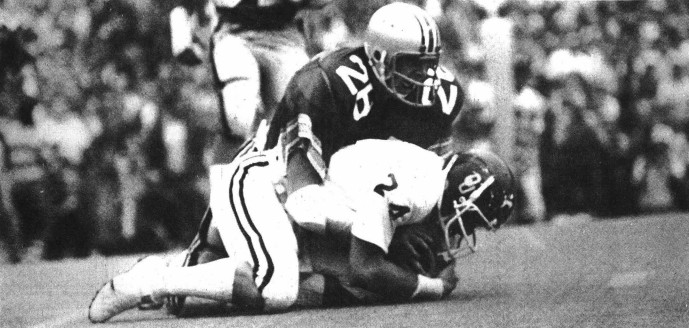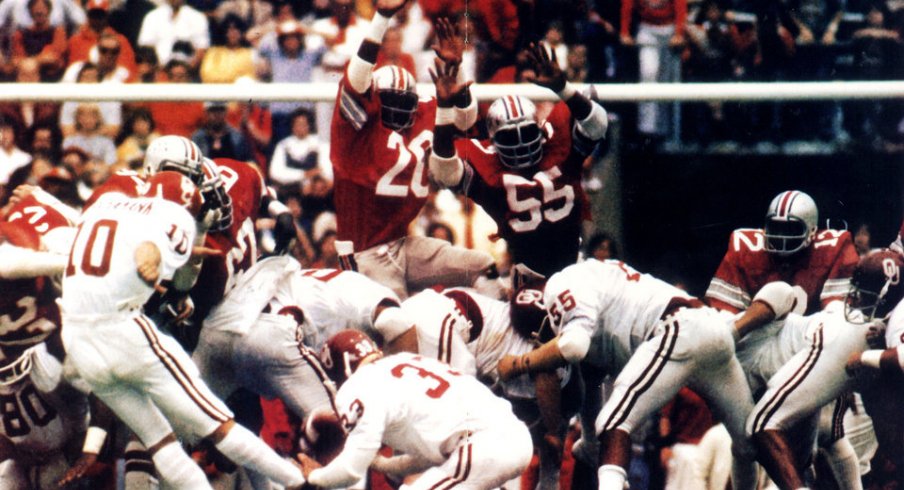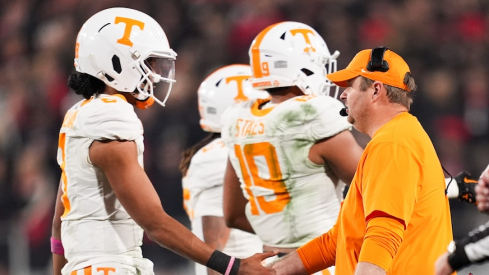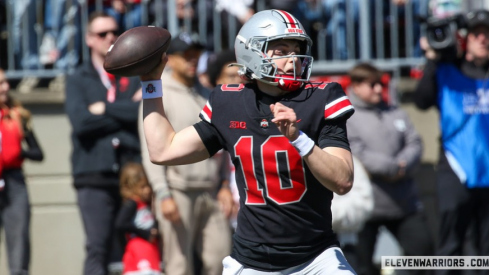The return leg of this home-and-home was always planned for 2017, on the 40-year anniversary of "The Kick."
Ohio State and Oklahoma announced this home-and-home series in January 2008, scheduling two games in advance for 2016 and 2017. The return leg of this home-and-home was always planned for 2017, on the 40-year anniversary of "The Kick."
Ohio State and Oklahoma first met on September 26, 1977 in what amounted to a well-hyped style clash. The Buckeyes were the pride of the Midwest, coached by an old-school fundamentalist who had been a mainstay in the college football ranks since 1946.
Oklahoma had glory before, prominently under Bud Wilkinson, but the heights to which Barry Switzer catapulted the Sooners may have made Oklahoma nouveau riche in the 1970s. Switzer took over the program when Chuck Fairbanks left to coach the New England Patriots. Switzer, previously Fairbanks' offensive coordinator, inherited a loaded roster and promptly took it to the next level as he perfected the "wishbone offense." It's arguably the most prolific rushing offense in NCAA history.
The results were immediate. Oklahoma was undefeated in 1973, Switzer's first year as head coach. Oklahoma won national championships in 1974 and 1975, the first while on probation. Ohio State fans may remember that those years were national championships for Oklahoma because Woody Hayes' Buckeyes lost their respective Rose Bowls.
Adding to this clash of styles: Switzer was young, brash even. He took over the Sooners at 35-years-old. There was an undeniable swagger to Switzer's Sooners, in contrast to the more stately, if still quite gruff, demeanor to Hayes' Buckeyes.
The No. 4 Buckeyes and No. 3 Sooners billed their clash as a "superbattle" of top-five programs. However, the game looked like it would be a boat race with the Sooners outclassing the Buckeyes from the start.
Oklahoma had already run up a 14-0 lead before most Ohio State fans found their seats. Elvis Peacock capped Oklahoma's opening drive with a 33-yard rushing touchdown. Rod Gerald fumbled an option pitch on Ohio State's ensuing drive. Two plays and 45 seconds later, Billy Sims (next year's Heisman winner) found the end zone on a 14-yard run.
Ohio State's next two drives ended in three-and-outs. Oklahoma's next two drives ended in Uwe von Schamann field goals. Oklahoma scored the first 20 points of the game.

That's when Ohio State's roaring comeback started. The Buckeyes took over, down 20-0, with 12:55 remaining in the second quarter. Rod Gerald accounted for all but nine yards of the ensuing 80-yard drive, leading the Buckeyes to the end zone on a 30-yard option keep.
Thereafter, Oklahoma began a meltdown in which it is any wonder how this game became memorable at all.
Elvis Peacock fumbled on the second play of Oklahoma's next drive. Dave Adkins recovered. Rod Gerald scored on the next play, a 19-yard option keep off the right end. Ohio State cut the deficit to 20-14.
Oklahoma fumbled its next play from scrimmage, which cornerback Len Mills recovered. The Buckeyes and Sooners traded three-and-outs before Oklahoma fumbled again. Willie Beamon recovered the third lost Oklahoma fumble of the day (and fourth fumble overall).
Oklahoma's defense, not its offense, was responsible for holding the Sooners to a 20-14 halftime lead. The Sooners outgained Ohio State 188-108 at intermission and was 4-5 on third down to Ohio State's paltry 0-6. However, those three lost fumbles prevented Oklahoma from pouring it on the Buckeyes and gave Ohio State every opportunity to claw back.
Oklahoma continued to shoot itself in the foot in the third quarter. Jay Jimerson fumbled Oklahoma's first play from scrimmage to begin the third quarter. Len Mills recovered for the Buckeyes, though Ohio State missed an opportunity to capitalize when Vlade Janakievski's 54-yard field goal try fell short.
Ohio State took the lead after a quick OU possession when Joel Payton dived over left guard to cap a seven-play, 48-yard drive for the Buckeyes. This gave Ohio State a 21-20 lead.
More good fortune came in bunches on the next drive. Kelton Dansler intercepted a Dean Blevins pass on the third play from scrimmage. On the fifth play of the ensuing drive, Greg Castignola, subbing for the injured Rod Gerald, slipped a tipped ball by an Oklahoma defender to Jimmy Moore for a touchdown.
Ohio State's comeback amounted to 28 unanswered points to take a 28-20 lead. Mike Guess' interception of Dean Blevins on Oklahoma's next drive seemed to have sealed Oklahoma's fate.
However, Oklahoma saved its magic for the fourth quarter. Greg Castignola fumbled at the Sooners' 46-yard line with less than seven minutes remaining in the game. Oklahoma recovered and advanced the ball to the Ohio State 43-yard line. Oklahoma's 12-play, 57-yard drive consumed 4:55 and resulted in an Elvis Peacock one-yard dive to cut the Ohio State lead to 28-26.
Oklahoma's two-point attempt failed, but the onside kick was successful. Oklahoma took over at the 50-yard line with 1:21 remaining. Dean Blevins' first play from scrimmage was an 18-yard pass to slot end Steve Rhodes to move the ball to the 32-yard line. Thereafter, Barry Switzer was clearly thinking a game-winning field goal attempt for Uwe von Schamann.
Uwe von Schamann will always have his place in Sooners history for what followed. He was an oddity at the time, a German immigrant from Fort Worth by way of Berlin. He was a "European soccer-style" kicker before that became the norm. His clutch game-winning kick into a wall of Ohio State fans in the north end zone, all chanting "block that kick" in vain hopes their will would prevent a Sooners win, sealed his place in Oklahoma lore. There is no shortage of paintings in Owen Field and around Norman that deify von Schamman's game-winning field goal.
Ohio State, down 29-28, had one play left after Oklahoma kicked off. This is true despite the fact Oklahoma's visiting fans began to prematurely storm Ohio Stadium's field with three second remaining. However, the outcome was never in doubt at this point. A self-defeating 13-yard scramble from Greg Castignola ended what was already a fait accompli.
Ask a Baby Boomer Ohio State fan about "The Kick" game and you might hear them talk about it as older Millennials would describe the 2007 Fiesta Bowl. It was that deflating. It was that infuriating. Oklahoma fumbled seven times and lost four of them. Oklahoma's Dean Blevins coughed up two interceptions on top of that for six total turnovers; his completions-to-INT ratio was 3/2 of five passes attempted against Ohio State's defense. Ohio State ran off 28 unanswered points over the visiting Sooners. Ohio State even persevered injuries to Rod Gerald and Tom Cousineau. Ohio State had an eight-point lead with less than two minutes remaining. Ohio State lost.
There is any number of "end of an era" games that Ohio State fans can circle for when Woody Hayes jumped the shark before punching Charlie Bauman in Jacksonville. Take your pick among the 1976 Rose Bowl, the loss to Missouri in 1976, the three-straight losses to Michigan, or the fateful decision to humor Art Schlichter and his father by moving Rod Gerald to split end to start the 1978 season. I would pick this game as that moment when Woody Hayes' 1970s dynasty effectively ended. It was the signal that Ohio State was no longer the elite program it was with the "Fab Four" backfield just a few years earlier.
Sure, Ohio State shared a Big Ten championship with Michigan in 1977, but it lost to No. 5 Michigan, 14-6, in Ann Arbor. Michigan went to the Rose Bowl to lose to the Pac-10 representative (Washington), as was Michigan's tradition of the time. Ohio State went to the Sugar Bowl where No. 3 Alabama ran it over, 35-6. There was no superlative in 1978, Woody Hayes' last year as coach. Ohio State would not beat a ranked team until Earle Bruce led the Buckeyes to a 17-13 win over No. 17 UCLA in the Coliseum in 1979.
Incidentally, Ohio State would not beat a top-ten team again until the return leg in 1983 when the No. 6 Buckeyes beat the No. 2 Sooners, 24-14, in Norman.
The game tomorrow is a deliberate marker for the 40-year anniversary of a legendary moment in Oklahoma football history. Ohio State has since exorcised that twice with convincing wins in Norman in 1983 and last year. Tomorrow might mean more for Ohio State fans who remember "The Kick" well and grimace every time it's mentioned.


